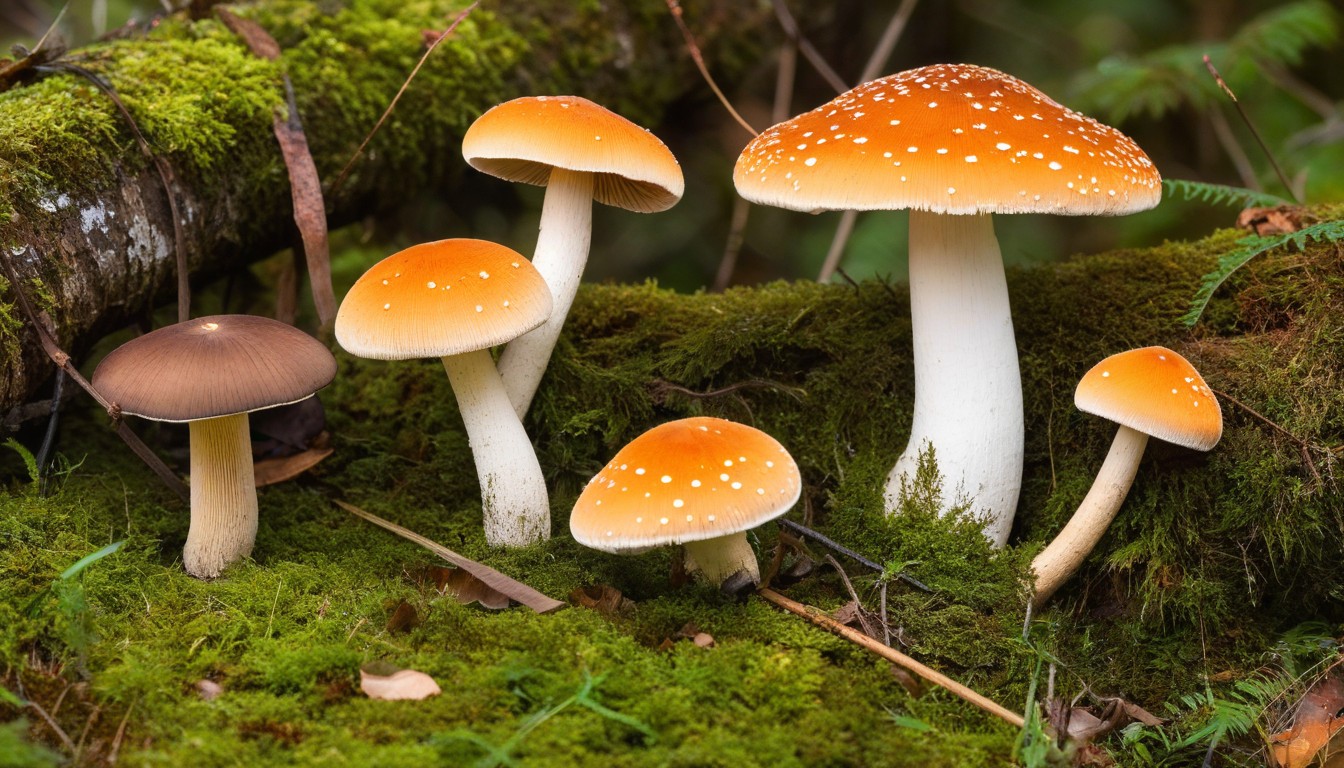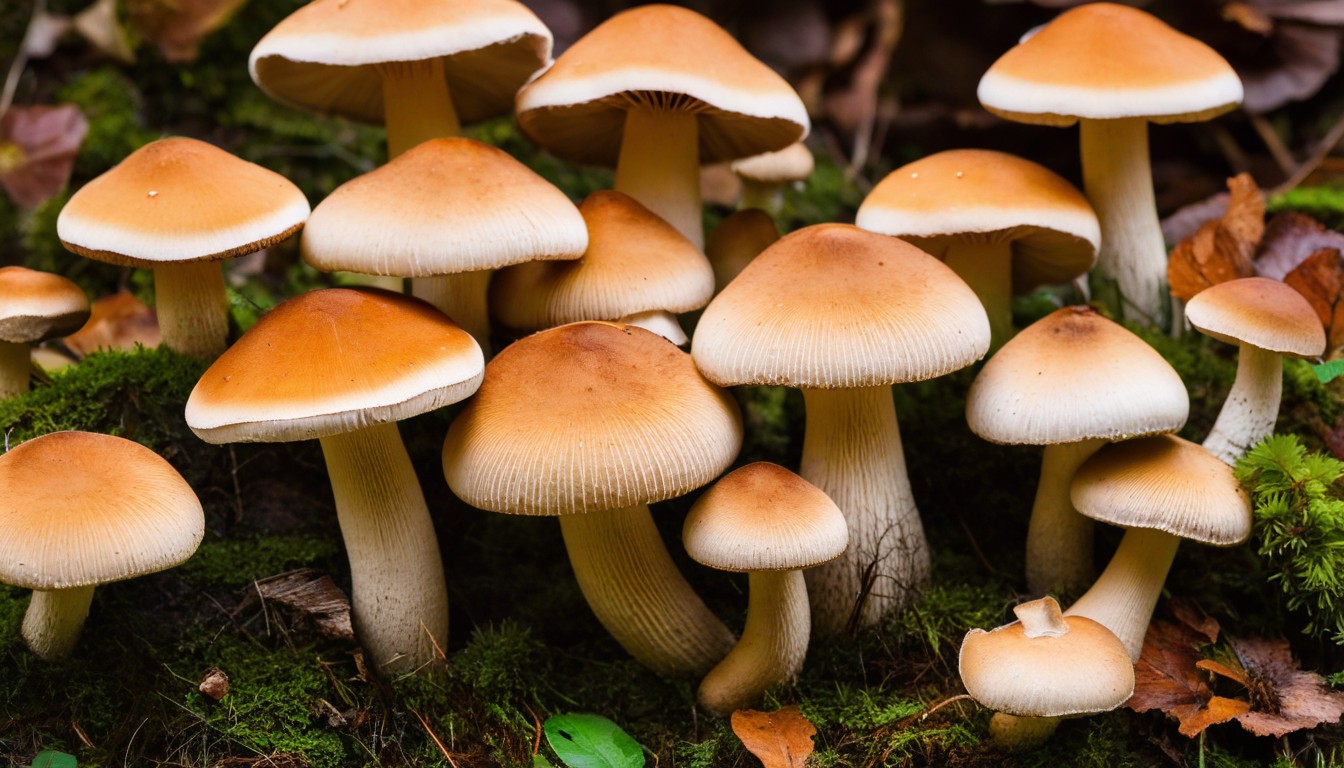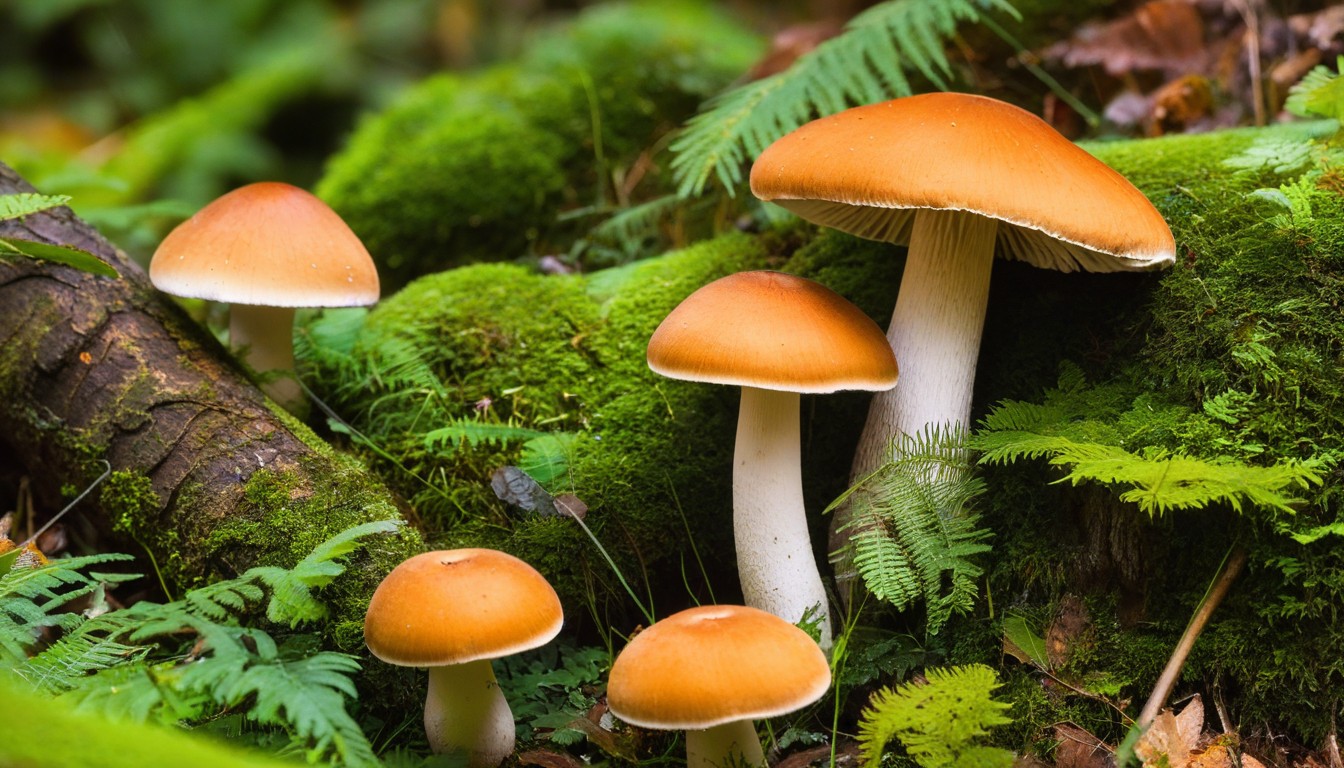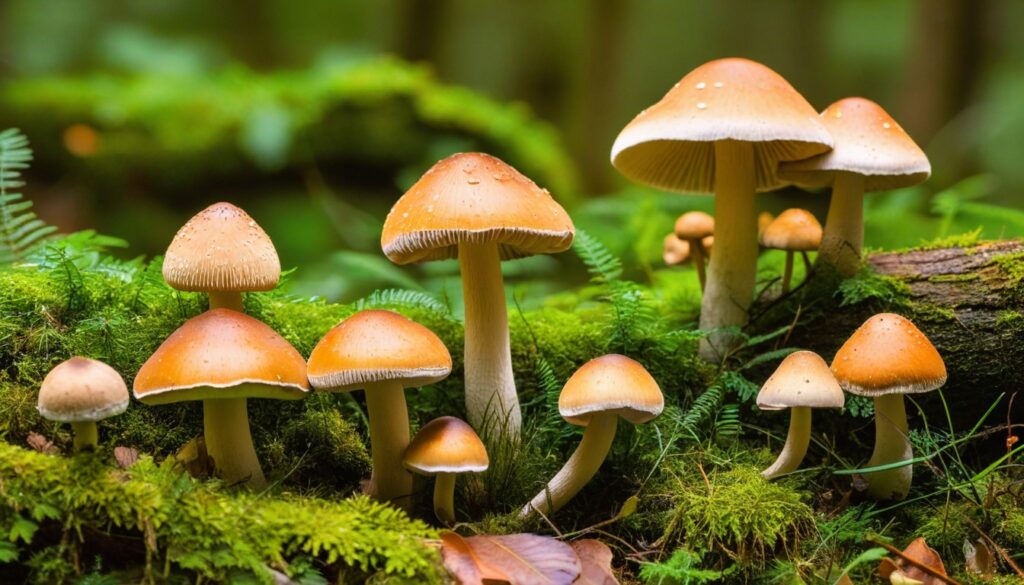Foraging for edible wild mushrooms in Oklahoma is an exciting outdoor activity that allows you to explore the natural beauty of the state while discovering and enjoying its diverse mushroom species. However, it can also be risky if you are not familiar with the unique characteristics of each variety.
In this guide, we will provide you with valuable information and expert tips on identifying, harvesting, and storing the top edible wild mushroom species found in Oklahoma. We will also cover essential safety precautions, cooking techniques, potential health benefits, and sustainability practices that will help you become a responsible and successful mushroom forager.
Key Takeaways:
- Foraging for edible wild mushrooms in Oklahoma can be a fun and rewarding activity.
- Identifying each wild mushroom species is crucial for safety.
- This guide provides helpful tips for harvesting, storing, and cooking wild mushrooms.
- Understanding the importance of responsible and ethical foraging is essential for sustainability.
- There are resources available in Oklahoma to help mushroom foragers expand their knowledge and skills.
Importance of Identifying Edible Wild Mushrooms
Foraging for edible wild mushrooms can be a rewarding and enjoyable experience, but it is crucial to be able to accurately identify the different varieties before consuming them. Many wild mushrooms look similar, and consuming misidentified or poisonous mushrooms can have serious health consequences.
Identifying edible mushrooms involves a careful examination of various physical characteristics, such as the shape, color, texture, and smell. It is important to note that relying solely on these characteristics can be risky, and some mushrooms may require more advanced identification techniques, such as spore prints and microscopic analysis.
Learning to identify edible mushrooms takes time, practice, and dedication, but the benefits are manifold. By being able to differentiate between safe and poisonous species, foragers can enjoy the delicious flavors and health benefits of wild mushrooms with peace of mind.
“I always stress the importance of correctly identifying wild mushrooms. Picking and eating the wrong mushroom can be fatal.”
– Laura Ramie, Oklahoma State University Extension Coordinator
Top Edible Mushroom Species in Oklahoma
Oklahoma is a haven for mushroom foragers, boasting a diverse array of edible mushroom species that thrive in its varied habitats. Here are some of the top choices:
Mushroom Species | Characteristics | Preferred Habitat |
|---|---|---|
Morels | Distinct wrinkled cap, hollow stem | Moist soils near hardwood trees in spring |
Chanterelles | Bright yellow-orange cap and stem, wavy edges | Moist woods near oak or pine trees in summer and fall |
Chicken of the Woods | Bright yellow-orange shelf-like cap, no stem | Grows on dead or decaying hardwoods in summer and fall |
Hedgehogs | Small, toothed cap, spiny underside | Moist woods near deciduous and conifer trees in late summer and fall |
Puffballs | Round and smooth with no stem, white flesh | Open areas like fields and meadows in fall |
These mushrooms are prized for their unique flavors and versatile culinary uses, making them a sought-after ingredient in numerous dishes and recipes. However, it’s crucial to accurately identify these species before consumption to avoid the potential risks associated with consuming misidentified varieties.
For novice foragers, consider attending guided mushroom foraging events or workshops led by experienced instructors who can teach you the skills and knowledge needed to safely and sustainably forage for edible wild mushrooms in Oklahoma.
Where to Find Edible Wild Mushrooms in Oklahoma

If you’re just starting out with mushroom foraging in Oklahoma, it can be challenging to know where to begin your search. The state is home to numerous habitats where wild mushrooms thrive, and some species are more likely to be found in certain areas than others.
The forests, meadows, and riverbanks throughout Oklahoma are all prime locations for mushroom hunting. Look for areas with ample shade, moisture, and decaying organic matter, as these are ideal environments for many species of edible mushrooms.
When first starting out, it’s best to explore different regions of the state to get a sense of where different edible mushroom species can be found. Keep in mind that the availability of certain mushrooms can vary by season and weather conditions, so it’s important to be patient and flexible in your search.
One useful tip for finding mushroom hotspots is to look for signs of previous growth, such as logs with visible spores or areas where the ground has been disturbed or overturned by wildlife.
Seasonal Availability of Edible Wild Mushrooms in Oklahoma
Mushroom Species | Seasonal Availability |
|---|---|
Morels | Spring (March to May) |
Chanterelles | Summer (June to August) |
Chicken of the Woods | Summer and Fall (June to November) |
Hen of the Woods | Summer and Fall (June to November) |
Oyster Mushrooms | Summer and Fall (June to November) |
It’s important to note that these seasonal availability windows are general guidelines and can vary based on weather and environmental conditions. It’s always best to do your own research or consult with an experienced forager to get the most accurate information on when and where to find specific mushroom species in Oklahoma.
Foraging Safety Tips

Foraging for wild mushrooms can be a rewarding experience, but it’s crucial to prioritize safety to avoid potential risks and health hazards. When mushroom foraging in Oklahoma, keep the following foraging safety tips in mind:
- Dress appropriately: Wear sturdy, waterproof footwear and long pants to protect your skin from insect bites and scratches.
- Bring a field guide: Carry a reliable mushroom identification guide or use a mobile phone app to ensure accurate identification of edible mushrooms.
- Learn to identify toxic look-alikes: Familiarize yourself with poisonous mushroom varieties that may resemble edible species, including the false Morels and Death Cap mushrooms.
- Harvest responsibly: Avoid over-harvesting, and only collect mature, healthy specimens. Leave smaller mushrooms to grow and spread spores for future generations. Remember to keep your harvesting bag open or use a basket to let spores fall down and spread.
- Protect the ecosystem: Avoid damaging the environment by not picking mushrooms too close to the ground or pulling it out by the roots. Only take what you need, and don’t leave any trash or debris behind.
- Don’t eat everything you find: It’s crucial to be certain of a mushroom’s identification before eating it. When in doubt, leave it untouched.
Note: If you are new to foraging, it’s recommended to forage with someone experienced for the first time, or attend a mushroom foraging workshop or guided tour to learn foraging and identification methods.
By following these simple mushroom foraging safety tips, you can ensure a successful and enjoyable foraging experience while minimizing risks to your health and the ecosystem around you.
Harvesting and Storing Edible Mushrooms
Harvesting wild mushrooms can be a rewarding experience, but it is vital to ensure that you follow proper techniques and precautions. Here are some essential tips to help you harvest and store foraged mushrooms safely.
Harvesting Tips:
- Use a sharp knife or scissors to cut the mushroom at its base, leaving the root intact to allow for regrowth.
- Be sure to handle the mushroom carefully and avoid damaging the cap or stem.
- Only harvest mushrooms that are fully grown and free of any insect damage, discoloration, or decay.
- When in doubt, err on the side of caution and leave any mushrooms that you cannot positively identify.
Storing Tips:
Proper storage is essential to maintaining the freshness and flavor of your harvested mushrooms. Follow these tips to ensure that your mushrooms stay in excellent condition:
- Do not wash mushrooms until you are ready to use them, as excess moisture can cause them to spoil quickly.
- Store mushrooms in a paper bag or a breathable container to allow for air circulation.
- Never store mushrooms in plastic bags or airtight containers, as this can cause moisture to build up and promote spoilage.
- You can also dehydrate mushrooms or freeze them to extend their shelf life further.
By following these harvesting and storage tips, you can enjoy the delicious flavors and nutritional benefits of wild mushrooms all year round.
Culinary Uses of Edible Wild Mushrooms

Foraging for edible wild mushrooms can be an exciting and rewarding experience for foodies and nature lovers alike. Oklahoma boasts a variety of tasty and nutritious species that can be used in a variety of delectable dishes.
Cooking Techniques
The key to cooking with wild mushrooms is to keep it simple. Due to their unique flavor and texture, they can be enjoyed with minimal preparation. However, before cooking, it is essential to clean the mushrooms thoroughly, removing any debris or dirt. Avoid washing them with water, as they may absorb too much moisture. Instead, wipe them gently with a dry cloth or brush. Once cleaned, you can sauté, grill or roast them.
Recipes
There are numerous recipes that incorporate the rich flavor and meaty texture of wild mushrooms. Here are some ideas to get you started:
Dish | Ingredients | Instructions |
|---|---|---|
Mushroom Risotto | Arborio rice, shallots, garlic, white wine, chicken broth, wild mushrooms, parmesan cheese, parsley, butter, olive oil, salt, and pepper. | Sauté shallots and garlic in butter and oil, add the rice, white wine and chicken broth; stir until cooked. Sauté wild mushrooms separately, add to the rice mixture, then sprinkle with cheese, parsley, and salt to taste. |
Mushroom Soup | Mushrooms, onion, garlic, chicken or vegetable broth, heavy cream, thyme, salt, and pepper. | Sauté onions and garlic; add the mushrooms and seasonings, cook until tender. Add chicken or vegetable broth, bring to boil and simmer for 20 minutes. Add heavy cream and blend until smooth. |
Wild Mushroom Pizza | Pizza crust, pizza sauce, wild mushrooms, mozzarella cheese, olive oil, salt, and pepper. | Spread pizza sauce on crust. Sauté wild mushrooms with salt and pepper; add to pizza, then sprinkle mozzarella cheese. Bake pizza in the oven for about 15 minutes, or until crust is golden brown. |
With a little creativity, wild mushrooms can be used in a range of dishes, from stir-fries and omelets to sauces and toppings.
Remember, always double-check the edibility of a wild mushroom before cooking with it. Happy foraging!
Medicinal Properties of Wild Mushrooms

For centuries, various cultures have utilized the medicinal properties of wild mushrooms for health benefits. While research is still ongoing, current studies suggest that certain edible wild mushrooms have the potential to boost the immune system and offer antioxidant benefits.
One of the most widely known medicinal mushrooms is Reishi, also known as Lingzhi. Native to Asia, Reishi has been used for centuries in Traditional Chinese Medicine as a natural remedy for boosting the immune system, increasing energy, and reducing stress. Western research has shown that Reishi mushrooms contain compounds that can enhance immune function and reduce inflammation.
Another mushroom with promising medicinal properties is Turkey Tail, also known as Trametes versicolor. This mushroom grows abundantly in forests across North America and has been used in traditional medicine to treat a variety of ailments. Research suggests that Turkey Tail mushrooms contain immune-boosting compounds that may be effective in preventing and treating certain types of cancer.
Other commonly consumed wild mushrooms that possess potential medicinal properties include Lion’s Mane, Chaga, and Cordyceps. Each of these mushrooms has unique characteristics and advantageous benefits, making them suitable for different medicinal uses.
Sustainability and Ethical Foraging in Oklahoma
Foraging for edible wild mushrooms can be a rewarding and enjoyable experience, but it is essential to do so responsibly to protect the delicate ecosystems where they grow. By following sustainable foraging practices and ethical mushroom harvesting principles, you can help maintain healthy mushroom populations in Oklahoma for generations to come.
Sustainable Foraging Practices
When foraging for wild mushrooms, it’s essential to minimize your impact on the ecosystem. This can include:
- Only taking what you need and leaving the rest for other foragers and wildlife
- Avoiding damaging or destroying surrounding flora and fauna
- Respecting the natural habitats of mushrooms and other wildlife
- Not using tools that could damage the soil or surrounding plants
- Taking care not to trample on the ground or disturb wildlife while foraging
Ethical Mushroom Harvesting
When harvesting wild mushrooms, it’s crucial to do so in an ethical manner to maintain healthy mushroom populations and preserve the environment’s balance. This can include:
- Avoiding over-harvesting mushrooms and instead allowing them to mature and release their spores
- Not harvesting from endangered or protected areas
- Leaving no trace and taking all waste with you
- Adhering to state and local regulations regarding foraging, mushroom hunting, and harvesting
- Respecting private property and gaining permission from landowners before foraging on their land
By following sustainable foraging practices and ethical mushroom harvesting principles, you can help preserve Oklahoma’s natural resources and enjoy the pleasures of mushroom foraging for years to come.
Foraging Resources in Oklahoma
Foraging for mushrooms in Oklahoma can be a delightful experience filled with discoveries, learning, and connection with nature. However, it’s essential to get educated before heading out to the woods to ensure safe and sustainable practices. Here are some helpful resources to get you started:
Books and Guides
- The Forager’s Harvest: A guide to identifying, harvesting, and cooking wild edible plants by Samuel Thayer. This comprehensive book covers more than 50 wild plants and their culinary potential, including mushrooms, nuts, berries, and more.
- Edible Wild Mushrooms of North America: A Field-to-Kitchen Guide by David W. Fischer and Alan E. Bessette. This guide covers over 100 species of wild mushrooms with detailed descriptions, photos, and cultivation tips.
- Oklahoma State University Extension: Provides a range of resources for mushroom identification, including free publications, links to online resources, and tips for safe foraging practices.
Online Communities and Workshops
- Oklahoma Mycological Society: A non-profit organization dedicated to the study and appreciation of mushrooms. The group offers educational programs, foraging trips, and identification workshops throughout the year.
- Facebook Foraging Groups: Several Facebook groups, such as “Oklahoma Foraging and Wildcrafting” and “Wild Edibles and Herbals of Oklahoma,” provide forums for sharing knowledge, asking questions, and connecting with other foragers in the state.
- Online Workshops: Various organizations and individuals offer online workshops covering mushroom identification, cultivation, and cooking. Some examples include Mushroom Mountain’s “Identify that Mushroom!” course and Wild Ozark’s “Mushroom Cultivation Crash Course.”
Remember to always prioritize safety and sustainability when foraging for mushrooms. Take time to learn about the different species, their habitats, and how to properly identify them. Be respectful of private and public land and only harvest within legal boundaries. Happy foraging!
Precautions and Mushroom Poisoning Symptoms
Foraging for wild mushrooms can be a thrilling activity, but it’s essential to be cautious and aware of the potential dangers. There are various poisonous mushroom species in Oklahoma that can cause severe health issues or even be fatal if consumed.
Some of the most common poisonous mushrooms you may encounter in Oklahoma include:
Mushroom Name | Poisonous Symptoms |
|---|---|
Death cap (Amanita phalloides) | Symptoms don’t appear for 6-12 hours and include nausea, vomiting, and diarrhea. The toxins target the liver and can cause severe liver damage or death. |
False morels (Gyromitra species) | Symptoms appear 5-24 hours after ingestion and include headaches, dizziness, vomiting, and diarrhea. The toxins in false morels can cause seizures, liver damage, and even coma. |
Conocybe and Galerina species | Symptoms appear 1-2 hours after ingestion and include nausea, vomiting, and diarrhea. These mushrooms contain the toxin amatoxin, which can cause liver damage or failure. |
If you suspect mushroom poisoning, it’s crucial to seek medical attention immediately. Symptoms of mushroom poisoning may include abdominal pain, nausea, vomiting, diarrhea, sweating, confusion, and liver and kidney failure.
Remember, the best way to avoid mushroom poisoning is to practice caution and only consume mushrooms that you have accurately identified as edible. If you are unsure about a mushroom’s identification, always err on the side of caution and avoid consuming it.
Conclusion
We hope this foraging guide has provided you with valuable insights and information on the diverse world of edible wild mushrooms in Oklahoma. Remember to always prioritize safety and responsible foraging practices, including proper identification techniques and sustainable harvesting methods.
With patience, practice, and a little bit of luck, mushroom foraging can be a fun and rewarding activity that connects you to nature and provides a delicious addition to your meals. So grab your basket and head out into the great outdoors – who knows what treasures you may discover!
FAQ
What is the purpose of this guide?
This guide aims to provide a comprehensive resource for foraging edible wild mushrooms in Oklahoma. It includes information on identification, safety, harvesting, culinary uses, and more.
Why is it important to accurately identify edible wild mushrooms?
Accurate identification is crucial for safety reasons. Consuming misidentified mushrooms can lead to serious illness or even death. It is essential to be able to distinguish edible varieties from poisonous look-alikes.
What are some popular edible mushroom species found in Oklahoma?
Some popular edible mushroom species in Oklahoma include Morels, Chanterelles, and Chicken of the Woods. This guide explores these species and others in detail.
Where can I find edible wild mushrooms in Oklahoma?
Edible wild mushrooms can be found in various habitats such as forests, meadows, and riverbanks in Oklahoma. This guide provides tips for finding mushroom hotspots and understanding seasonal availability.
Are there any safety precautions I should take while foraging for wild mushrooms?
Yes, safety is paramount. This guide covers essential safety tips, including the use of appropriate gear, identification of poisonous look-alikes, and responsible harvesting practices to preserve the ecosystem.
How should I harvest and store edible mushrooms?
Proper harvesting techniques and storage methods are important for maintaining freshness. This guide provides step-by-step instructions and tips for safely harvesting and storing edible mushrooms.
What are some culinary uses of edible wild mushrooms?
Edible wild mushrooms can be incorporated into a variety of dishes and recipes. This guide explores different cooking techniques and highlights the unique flavors and textures of Oklahoma’s edible mushrooms.
Do wild mushrooms have any medicinal properties?
Some edible wild mushrooms possess medicinal properties, including immune-boosting effects and antioxidant properties. This guide explores the potential health benefits of certain mushrooms found in Oklahoma.
How can I forage for mushrooms in a sustainable and ethical manner?
It is essential to practice sustainable foraging to protect the environment and mushroom populations. This guide provides insights into responsible foraging practices, such as leaving no trace and respecting wildlife habitats.
What are some foraging resources available in Oklahoma?
Oklahoma offers various resources for mushroom foragers, including books, online communities, workshops, and organizations. This guide highlights some valuable sources of information and support for mushroom enthusiasts.
What are the precautions and symptoms of mushroom poisoning?
While foraging, it is important to be aware of poisonous mushrooms and their associated symptoms. This guide discusses common poisonous mushrooms in Oklahoma and provides guidance on recognizing and responding to mushroom poisoning.

